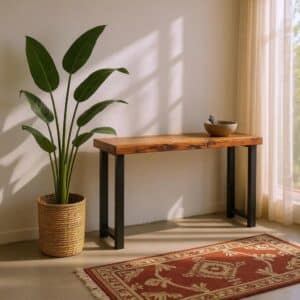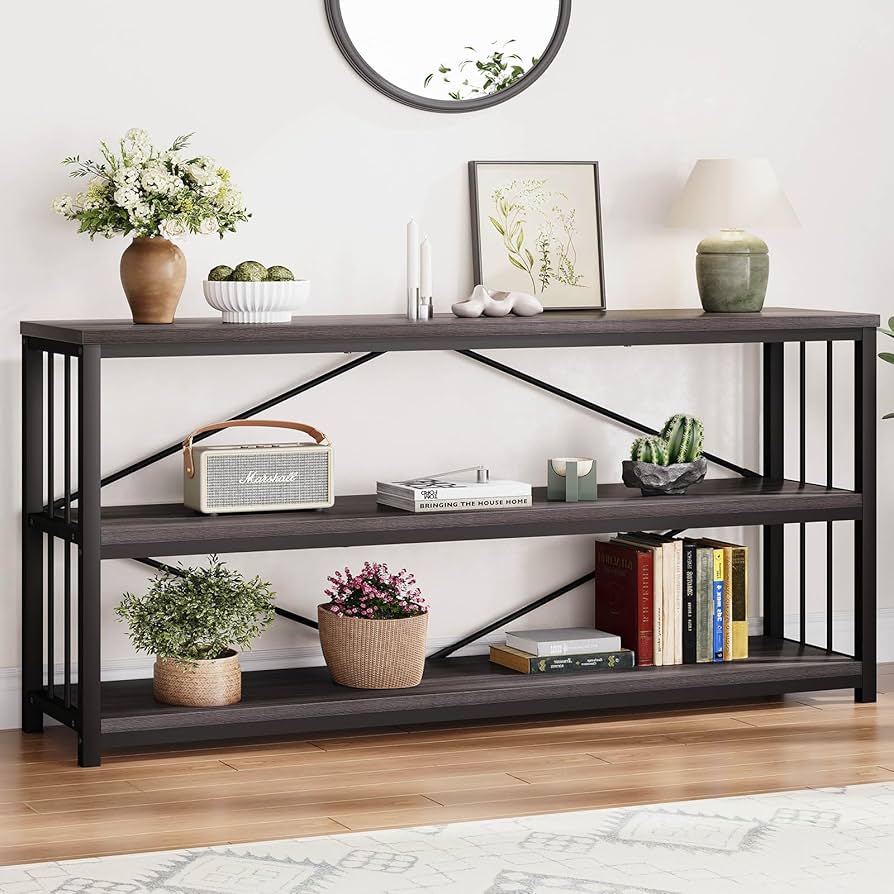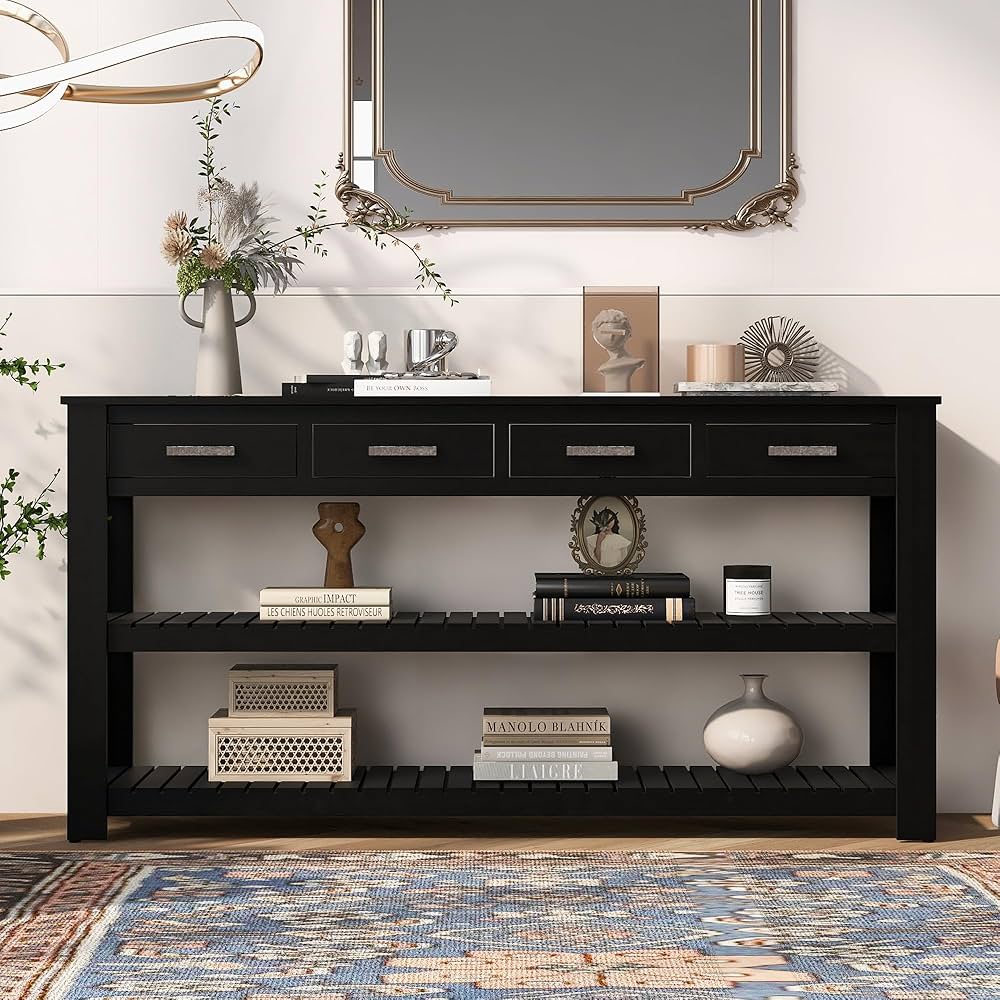Choosing the right size for your entryway table can make a big difference in how welcoming and functional your space feels. You might wonder, “How long should my entryway table be?” This question matters because the perfect length helps keep your entry clutter-free while fitting your space just right.
You’ll discover simple tips to find the ideal table length that matches your entryway’s size and style. Keep reading to transform your entryway into a spot that’s both beautiful and practical.

Credit: www.amazon.com
Entryway Table Basics
Choosing the right entryway table length is key for a balanced and functional space. The basics include understanding the types and uses of these tables. This knowledge helps pick a table that fits well and serves your needs perfectly.
Common Entryway Table Types
- Console Tables:Slim and long, ideal for narrow spaces.
- Hall Tables:Traditional style, often with drawers for storage.
- Accent Tables:Smaller, decorative tables that add style.
- Storage Tables:Include shelves or cabinets for extra space.
Functions Of An Entryway Table
- Provides a spot to place keys, mail, and small items.
- Acts as a decorative element to welcome guests.
- Offers storage for shoes, bags, or hats.
- Helps organize daily essentials for easy access.
Measuring Your Space
Measuring your entryway space is the first essential step toward choosing the right table size. Without accurate measurements, even the most stylish table can make your entryway feel cramped or awkward. Taking your time with this process ensures your table fits perfectly and complements the flow of your home.
Assessing Entryway Dimensions
Begin by measuring the width and length of your entryway. Use a tape measure to get precise numbers, noting any nearby doors, windows, or architectural features that may impact table placement.
Remember to measure the wall space where you plan to place the table. For instance, if your entryway is only 36 inches wide, a 48-inch table will overwhelm the space.
Write down these dimensions and keep them handy. They will guide you in selecting a table that fits without crowding your area.
Considering Traffic Flow
Think about how people move through your entryway daily. Your table should not block the natural path or make the space feel tight.
Leave at least 30 inches of clearance between the table and any opposing walls or furniture to allow easy movement. If you expect guests or family members to carry bags, coats, or other items, consider adding even more space.
Ask yourself: Does your entryway accommodate smooth traffic even when the table is in place? If not, a narrower or smaller table might be a better choice.
Ideal Table Lengths
The entryway table is a vital part of home decor. Its length should balance the space it occupies and the function it serves. Choosing the right length enhances both aesthetics and utility. Let’s explore ideal table lengths for your entryway.
Standard Length Ranges
Entryway tables come in different lengths to suit various needs. Standard lengths generally range between 30 to 60 inches. A 30-inch table fits small spaces perfectly. For medium-sized spaces, a 48-inch table works well. Large entryways accommodate tables up to 60 inches, offering ample surface area.
Matching Table Size To Wall Space
Align your table with the wall’s length for harmony. A table should cover two-thirds of the wall space. This proportion keeps the table from overpowering the wall. It also ensures the room feels balanced. Measure your wall before choosing a table to find the right fit.
Balancing Height And Depth
Balancing the height and depth of your entryway table ensures it fits perfectly in your space. The right size adds style without crowding the area. It also makes the table more useful and comfortable to use every day.
Height Recommendations
The height of the table should match nearby furniture. Generally, it should be close to the height of your sofa or chair arms. This makes the table easy to reach and visually balanced. A common height range is 28 to 32 inches. Avoid a table that is too tall or too low. It can look awkward and reduce its function.
Optimal Depth For Functionality
Depth affects how much you can place on the table. A depth of 12 to 18 inches works well in most entryways. It allows space for keys, mail, and decorations without blocking walkways. Too deep a table can make the space feel cramped. Too shallow may limit storage and use. Choose a depth that fits your space and needs perfectly.
Design And Style Tips
Design and style play a big role in choosing the right entryway table length. The table should look balanced and fit the space well. It also needs to match the style of your entryway and the rest of your home. Thoughtful design choices make the entryway inviting and practical.
Choosing Proportions For Aesthetics
The length of the table should relate to the wall or space it sits against. A table too long or too short can look awkward. Aim for a table that fills about two-thirds to three-quarters of the wall. Keep enough room on both sides for easy movement.
Height matters too. It should be about waist level for most people. This balance helps the table look natural and easy to use. Consider the table’s depth as well—deep enough for decor but not too wide to block the pathway.
Complementing Other Entryway Elements
Match your entryway table with the style of other items nearby. Think about the door, floor, and lighting. Choose colors and materials that blend well together. For example, a wooden table fits nicely with warm tones and natural elements.
Use the table as a base for decor items like mirrors, lamps, or baskets. These pieces should not overpower the table but enhance its look. Keep the area tidy to maintain a welcoming feel. Balance function and style for a perfect entryway setup.

Credit: rcsuppliesonline.com
Custom Vs. Ready-made Tables
Choosing between custom and ready-made entryway tables affects both style and fit. Each option offers unique advantages. Custom tables can match your space exactly, while ready-made tables provide quick, budget-friendly choices. Understanding these differences helps you pick the best table length for your entryway.
Benefits Of Custom Sizing
Custom tables fit your entryway perfectly. They maximize space without overcrowding. You can choose the exact length, height, and depth you need. Custom designs match your decor and personal taste. They allow unique shapes and storage options. This choice ensures your table complements your home’s style. Custom sizing avoids awkward gaps or tight fits.
Popular Ready-made Sizes
Ready-made tables come in common sizes for easy shopping. Typical lengths range from 36 to 60 inches. Widths often measure 12 to 18 inches. Heights usually fall between 28 and 32 inches. These sizes fit most entryways and hallways. Ready-made tables offer quick availability and lower prices. Many designs include shelves or drawers for storage.
Common Mistakes To Avoid
Choosing the right length for your entryway table can be tricky. Many people make simple mistakes that affect both the look and function of their space. Avoiding these common errors will help you create an entryway that feels inviting and works well for daily use.
Oversized Tables In Small Spaces
Putting a large table in a tight entryway might seem like a good idea to add storage or style. But oversized tables often overwhelm the space and make it hard to move around comfortably. If your entryway is narrow, a bulky table can block the flow and create a cramped feeling.
Think about the width of your hallway or foyer before choosing a table. A slim, longer table might work better than a deep, wide one. Have you measured your space carefully? This simple step can save you from a costly mistake.
Neglecting Clearance Needs
Clearance is key when placing an entryway table. You need enough room for people to walk by without bumping into the furniture. Ignoring clearance can make your entryway frustrating to use and even unsafe.
Leave at least 30 inches of clear space between the table and any opposite wall or door. This allows smooth passage and keeps your entryway functional. Do you know how much space you need to move comfortably in your entryway?
Additional Functional Features
Adding extra features to your entryway table boosts its usefulness. Functional elements make the table more than just a decorative piece. It can help organize your space and make daily routines easier. Consider features that fit your lifestyle and available space.
Storage Options
Storage helps keep the entryway tidy and clutter-free. Look for tables with drawers or shelves to store keys, mail, or gloves. Baskets or bins under the table add hidden storage for shoes or bags. Open shelves provide easy access to frequently used items. Storage keeps essentials within reach without crowding the surface.
Incorporating Seating
Seating adds convenience to your entryway table area. A small bench or stool fits well under the table without taking extra space. Seating makes it easier to put on or take off shoes. It also offers a quick place to sit while grabbing items. Choose compact seating that matches the table’s style and size.

Credit: www.amazon.com
Frequently Asked Questions
How Do I Measure The Right Length For An Entryway Table?
Measure your entryway wall space first. The table should be about two-thirds the width of the wall. Ensure enough room for walking around it comfortably.
What Size Entryway Table Fits Small Spaces Best?
Choose a table 24-36 inches long for narrow or small entryways. Slim and compact designs prevent crowding and maintain flow.
Should An Entryway Table Match The Hallway Width?
No, it should be shorter. Ideally, the table is two-thirds the hallway width to avoid crowding.
How Tall Should An Entryway Table Be?
Entryway tables usually stand 28-32 inches tall. This height is ergonomic for placing keys and decor.
Conclusion
Choosing the right length for your entryway table makes a big difference. It should fit the space without crowding it. A table that is too long or too short can look odd. Measure your wall and think about what you want to place on the table.
Balance is key for both style and function. This way, your entryway feels welcoming and neat. A well-sized table helps keep things organized every day. Simple steps lead to a beautiful, useful entryway space.





